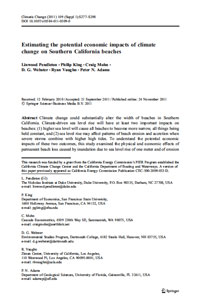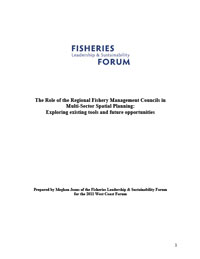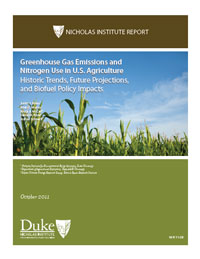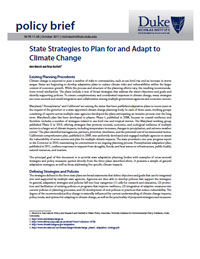Publications
Estimating the Potential Economic Impacts of Climate Change on Southern California Beaches
Climate change could substantially alter the width of beaches in Southern California. Climate-driven sea level rise will have at least two important impacts on beaches: (1) higher sea level will cause all beaches to become more narrow, all things being held constant, and (2) sea level rise may affect patterns of beach erosion and accretion when severe storms combine with higher high tides. To understand the potential economic impacts of these two outcomes, this study examined the physical and economic effects of permanent beach loss caused by inundation due to sea level rise of one meter and of erosion and accretion caused by a single, extremely stormy year (using a model of beach change based on the wave climate conditions of the El Niño year of 1982/1983.)
The impact of climate change on California’s ecosystem services
Ecosystem services play a crucial role in sustaining human well-being and economic viability. People benefit substantially from the delivery of ecosystem services, for which substitutes usually are costly or unavailable. Climate change will substantially alter or eliminate certain ecosystem services in the future. To better understand the consequences of climate change and to develop effective means of adapting to them, it is critical that we improve our understanding of the links between climate, ecosystem service production, and the economy. This study examines the impact of climate change on the terrestrial distribution and the subsequent production and value of two key ecosystem services in California: (1) carbon sequestration and (2) natural (i.e. non-irrigated) forage production for livestock.
West Coast Forum Summary: Coastal & Marine Spatial Planning and the Role of Regional Fishery Management Councils in Multi-Sector Spatial Planning
Summary of discussion themes and guide to additional resources from the 2011 West Coast Fisheries Forum.
Forum Report: The Role of the Regional Fishery Management Councils in Multi-Sector Spatial Planning: Exploring Existing Tools and Future Opportunities
This report was prepared for the 2011 West Coast Forum on coastal and marine spatial planning. The first part explores the originals and drivers of CMSP, and the potential role that the regional councils might play in a CMSP framework. The second part explores opportunities for Councils to utilize existing authorities and mechanisms to coordinate with other ocean users.
Greenhouse Gas Emissions and Nitrogen Use in U.S. Agriculture: Historic Trends, Future Projections, and Biofuel Policy Impacts
Agriculture is among the world’s largest sources of greenhouse emissions and is the largest source of certain types of anthropogenic nitrogen pollution. But as a source of renewable fuels production and carbon sequestration, agriculture could also be part of the solution to energy security and climate change problems. Similarly, improved management of agricultural nitrogen use could be the key to managing nitrogen pollution in surface- and groundwater systems. If policy makers are to determine how best to develop and implement effective policy interventions to correct environmental problems in agriculture, the critical linkages among demand, supply, land use, nitrogen use, and greenhouse gas emissions must be captured. This paper projects greenhouse gas emissions and nitrogen use from agricultural and forestry practices under baseline and alternative biofuel scenarios in the United States, while accounting for land use competition, production heterogeneity, and a full suite of biofuel production possibilities.
State Strategies to Plan for and Adapt to Climate Change
Climate change is expected to pose a number of risks to communities, such as sea-level rise and an increase in storm surges. States are beginning to develop adaptation plans to reduce climate risks and vulnerabilities within the larger context of economic growth. While the process and structure of the planning efforts vary, the resulting recommendations reveal similarities. The plans include a mix of broad strategies that address the state’s objectives and goals and identify supporting policies. To ensure complementary and coordinated responses to climate change, many strategies are cross-sectoral and entail integration and collaboration among multiple government agencies and economic sectors.
Stacking Ecosystem Services Payments: Risks and Solutions
A wide variety of incentive programs and markets have arisen to pay landowners for ecosystem services--the benefits that healthy ecosystems provide, such as water filtration, biodiversity, habitat protection, and carbon sequestration. This raises questions about whether landowners can receive more than one payment for ecosystem services generated from the same parcel of land, a practice known as "stacking." This paper outlines the different types of ecosystem service credits that can be stacked, and introduces a conceptual framework that can help policy makers and project developers determine whether a stacked project is meeting the objective of replacing or enhancing ecosystem services. It also identifies three specific circumstances in which stacking can lead to a negative outcome for ecosystem services and puts forward specific policy proposals to address these issues.
Myths and Facts About Electricity in the U.S. South
This paper identifies six myths about clean electricity in the southern United States. These myths are either propagated by the public at-large, shared within the environmental advocacy culture, or spread imperceptibly between policy makers. Using a widely accepted energy-economic modeling tool, the paper exposes these myths as half-truths and the kind of conventional wisdom that constrains productive debate. In doing so, it identifies new starting points for energy policy development.
A Silent Tsunami Revisited: Extending Global Access to Clean Water and Sanitation
While billions still lack safe drinking water and sanitation, access can be enhanced through improved policy and strategic outreach, according to this report by Duke University's Nicholas Institute for Environmental Policy Solutions and the Aspen Institute. A Silent Tsunami Revisited outlines the progress made on the expansion of water, sanitation and hygiene (WASH) services since its companion report was released in 2005. It highlights these experts' recommendations for improving the efficacy of the WASH sector and achieving universal access to safe water and sanitation.
Seeding the Market: Auctioned Put Options for Certified Emission Reductions
There are a number of reasons for considering some kind of market-based, pay-for-performance mechanism to mitigate developing country greenhouse gas (GHG) emissions. This policy brief lays out arguments for the auctioned put option as a pay-for-performance mechanism that would allow governments or philanthropic organizations to support and catalyze markets for GHG reductions. The existing offset market, with its detailed methodologies for calculating emission reductions, offers tools that could be borrowed by such a mechanism. Auctioned put options could target a subset of Clean Development Mechanism (CDM) projects—segregated by type of project or country of origin—or an entirely different set of activities, such as REDD+ (reduced emissions from deforestation and degradation plus conservation, sustainable forest management, and enhancement of carbon stocks). The key element is that there must be standardized rules (or the promise of rules) detailing how emission reductions get counted and certified.










